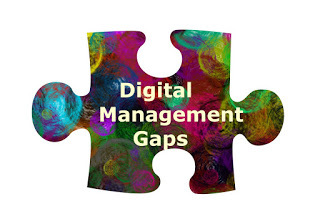The New Book “DIgital Gap” Chapter 3 Introduction: Digital Management Gaps
 Most organizations at the industrial age have been operated with classic management discipline, which is based on a tacit assumption that organizations can be compared to machines as a mechanical system. They are based on silo functions and divide-and-conquer methodologies which are promoted both in organizational design as well as task responsibility or accountability distribution. Nowadays, businesses are steadily moving into the digital era with characteristics of hyper-connectivity and interdependence, how to close the gap between classic management and digital management in order to improve business effectiveness and maturity?
Most organizations at the industrial age have been operated with classic management discipline, which is based on a tacit assumption that organizations can be compared to machines as a mechanical system. They are based on silo functions and divide-and-conquer methodologies which are promoted both in organizational design as well as task responsibility or accountability distribution. Nowadays, businesses are steadily moving into the digital era with characteristics of hyper-connectivity and interdependence, how to close the gap between classic management and digital management in order to improve business effectiveness and maturity?
Bridging strategy-operation management gap: Strategic management as a long-term planning requires a vision. In other words, a company needs to define which it wants to be with a clear vision and how they want to get there, and then operational management will translate the long-term plans into smaller scale plans to operationalize the move toward the vision. Generally speaking, strategy management takes a holistic view, and operational management takes an interval view. Operational management could be viewing things from a single side internally while strategic management is a holistic view of things both internally and externally as the way of coming up with actions that will improve organizational performance and conformance in order to achieve the set goals. Strategic management is concerned with establishing “where” the organization competes and “how” it chooses to compete and capture the market share; Operation Management, on the other hand, is concerned with a specific aspect of how such as the roles, process & procedure used to make decisions, and measurement, etc. They are complementary management approach to achieve digital management continuum.
Bridging IT-business gap: There are nature frictions between different functions of the organization, especially between business and IT. IT doesn’t exist to do everything it is asked, nor does it exist to implement without business justification. It is there to manage a scarce and expensive resource for the business, doing its best to see that the application of IT brings the best business results possible. However, often there is typically a significant gap between what the business wants and needs vs what IT is providing. The result is usually a lot of churns until they get it right. The bottom line is, for any company to succeed, it is essential for the entire company to be pulling in the right direction. IT is integral to the business. IT and the business need to develop a true partnership and work to pursue the desired outcome via bridging the multitude of gaps such as communication gaps, collaboration gaps, skill gaps, and performance measurement gaps, etc.
 Bridging innovation management gaps: Although innovation is listed at the top of every forward-looking organization’s agenda, there are both idea gap and execution gap existing in innovation management. Innovation is not serendipity, but a systematic process to transform novel ideas and achieve their business values. It requires a much deeper whole system with emergent, generative, iterative, and integrative approach. It requires much more time, energy, passion, courage, experimentation, retreat, and reflection to get clear and focused on the innovative idea, business model, process or solution. It is also critical to pulling the resources to build an innovation nurturing the working environment which can encourage talented people to develop their creativity, with the freedom to try and even to fail. Innovation management takes cohesive steps of minding the gaps, accelerating strategy execution and make a leap of the digital organization.
Bridging innovation management gaps: Although innovation is listed at the top of every forward-looking organization’s agenda, there are both idea gap and execution gap existing in innovation management. Innovation is not serendipity, but a systematic process to transform novel ideas and achieve their business values. It requires a much deeper whole system with emergent, generative, iterative, and integrative approach. It requires much more time, energy, passion, courage, experimentation, retreat, and reflection to get clear and focused on the innovative idea, business model, process or solution. It is also critical to pulling the resources to build an innovation nurturing the working environment which can encourage talented people to develop their creativity, with the freedom to try and even to fail. Innovation management takes cohesive steps of minding the gaps, accelerating strategy execution and make a leap of the digital organization.The very characteristics of digitalization are hyper-connectivity, hyper-complexity, and interdependence; with the exponential growth of information and fast-paced of changes, the traditional management practices are often just not fit enough for speeding up and toning the business capability to respond to the opportunities and risks, due the multiple gaps existing between functions and underlying processes; the management styles and the outdated “best practices,” they apply. It is imperative to close the modern management gap to harness communication and collaboration, and improving organizational agility, effectiveness, and maturity.Follow us at: @Pearl_Zhu
Published on March 26, 2017 23:10
No comments have been added yet.



